Installation Examples
Here are some examples of actual installation using Yamada Shadowless
Creating a Lighting Environment for Operating Rooms by Taking Advantage of LEDs and Devices
- Customer
- JA Nagano Kouseiren Nagano-Matsushiro Hospital
- Installation Facility
- Operation room
- Type of Light Installed
- Product Name:
IXM-CJ (LED shadowless lamps)
IXM-CK (LED ceiling lights)
IXM-CKC (control panel)
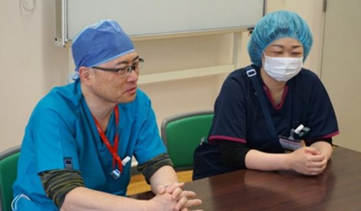
Head of Anesthesia Department Dr. Hiroyuki Mitono (left)
Chief Nurse of Surgical Nursing Department Ms. Sodeyama (right)
This time we inquired with Head of the Anesthesia Department Dr. Mitono and Chief Nurse of the Surgical Nursing Department Ms. Sodeyama regarding the lighting environment of the operating room and the sequence of events leading up to introducing the new lighting.
—Could you tell us a little about what led you to install new lighting?
Dr. Mitono:
Initially, we planned to use LEDs as shadowless lamps first, and thenmake the ceiling lights LEDs. At that time, we only planned on simply replacing the fluorescent lights with LEDs. We knew there were risks with LED light sources, but we didn’t have a detailed understanding.
We went to see the actual lights at the showrooms of various companies, and through their proposals, we came to a better understanding. We only first learned why generic LEDs are glaring upon hearing the mechanics and confirmation of the actual lights. Through the use of LED light sources, many of the shadowless lamps currently in use achieve higher illuminosity than shadowless lamps with halogen light sources. The shadowless lamps of Skylux reduce the strength of blue light using purple LEDs. They taught us that there are influences on the color temperature and of each of the types of LEDs.
—The head surgeon has to focus on the operation and keep looking for hours under bright lights. It is thought that the eyes could be affected. How does it actually feel using Skylux lamp in practice?
Dr. Mitono:
IThere had been subjective evidence that with generic LED lighting the back of the eyes would get tired, but using these CJ model shadowless lamps, I think that tiredness has been reduced.
Ms. Sodeyama:
I don’t feel like I get tired even when switching from looking at the high intensity area of operation field under the shadowless lamp to the surrounding low intensity area. It’s bright but my eyes don’t get tired. There are times we preset a higher illumination than normal using the touch panel and perform the operation.
Before Refurbishment—Fluorescent lights used as ceiling lights, and halogen light sources used as shadowless lamps
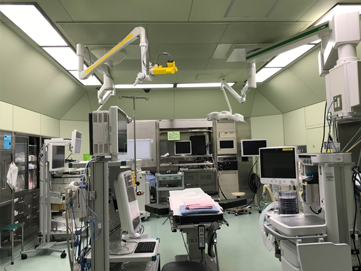
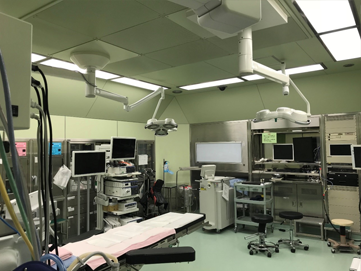
After Refurbishment—LEDs used as ceiling lighting and as shadowless lamps
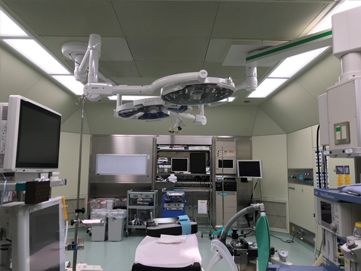
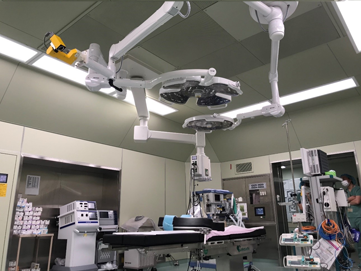
—Do you use other functions of the CKC control panel?
Ms. Sodeyama:
When the patient enters the room and when the patient wakes up from anesthesia, I switch the color mode of the ceiling lights to a relaxing warm tone so that it is not too bright.
Previously, regarding the switch of the shadowless lamps, depending on the technique, we had to use both hands to make an adjustment to the brightness of the main light and the auxiliary light, but now that the main light and auxiliary light are simultaneously linked to one button, we can use one hand to operate it.
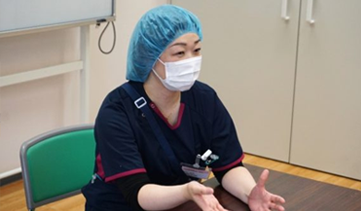
—It has been one month since the new lighting has been installed. How has it been received so far?
Ms. Sodeyama:
It’s nice that we don’t have to replace fluorescent light bulbs anymore. We used to have shadowless lamp bulbs burn out during an operation, and would have to change them. It’s really good that that hasn’t happened since switching to LEDs.
Dr. Mitono:
It doesn’t feel too bright when I enter the operating room. There is not any sense that it’s too bright when the shadowless lamps are on. It doesn’t even feel like they are on.
Also, when the focus function of the shadowless lamps is applied, the light is now able to reach deep into the narrow, dark area within the mouth. At first, I was unsure about whether to choose a straight shadowless lamp or a shadowless lamp with focus function, but once we actually used the shadowless lamp with focus function, surgical doctors had good things to say like that.
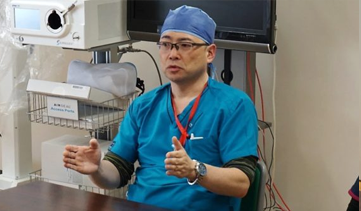
—Could you tell us about any times you have felt the color of lighting affecting someone?
Ms. Sodeyama:
When the patient enters the room, out of consideration for the patient, we change the color of the ceiling lights to a relaxed tone, and the medical staff sees that and realizes “A procedure is starting.”
Illumination is for keeping the sympathetic nerves active during an operation, so the illumination is bright, but not too bright, such that we can see the operating room environment (patient and tools) well.
—Do you have any thoughts about the lighting environment of hospital facilities in the future?
Dr. Mitono:
I think the overall balance of lighting is important, such as in the hallway and other areas, not just in the operating room. Recent designs for hospital construction allow for external light to shine in from the outside. I think the changes in tone of light and such are very important in terms of working environment for the medical staff. Most patients in the operating room are under anesthesia, so even though a lighting environment for operation that takes circadian rhythms into consideration may be difficult, it could be a good thing for the hospital.
Afterword
Thanks to this interview with Dr. Mitono and Chief Nurse Sodeyama, we were able to learn about how they investigated and compared the characteristics of various LED lights, particularly shadowless functionality, as well as how those lights would affect medical staff and patients, and how upon that understanding, they introduced those lights to create a lighting environment they continued to appreciate even after installation.
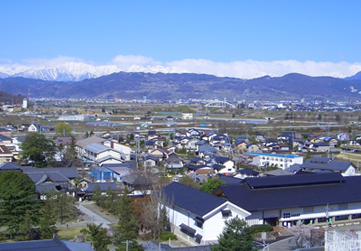
Fresh green growth of Sanada Park, the Sanada Treasures Museum, and the distant Northern Alps seen from the western side of the hospital
(Image from the hospital website)
Proposed The Neonatal Intensive Care Unit (NICU)
- Customer
- The Jikei University Hospital
- Installation Facility
- North ward, NICU room
- Type of Light Installed
- Product: Flat base light / Model No.: LGP01-018120-V64D-HR
The Neonatal Intensive Care Unit (NICU) is a space for treating newborns afflicted with various ailments, and we felt that it was necessary to create an environment that gives due consideration to newborns and to the environment in which treatment is administered, and so we proposed a lighting design using lighting simulation software
Details of Proposal:
In order to ensure that newborns, who have thin eyelids, are not overly affected by the brightness of the lights, we used a combination of low-glare lights as indirect illumination, and base lights for ensuring sufficient brightness during operations.
Additionally, the base lights provide a high color rendering light environment with heightened visibility, such that the condition of the newborn can be accurately judged by changes in the newborn’s thin skin.
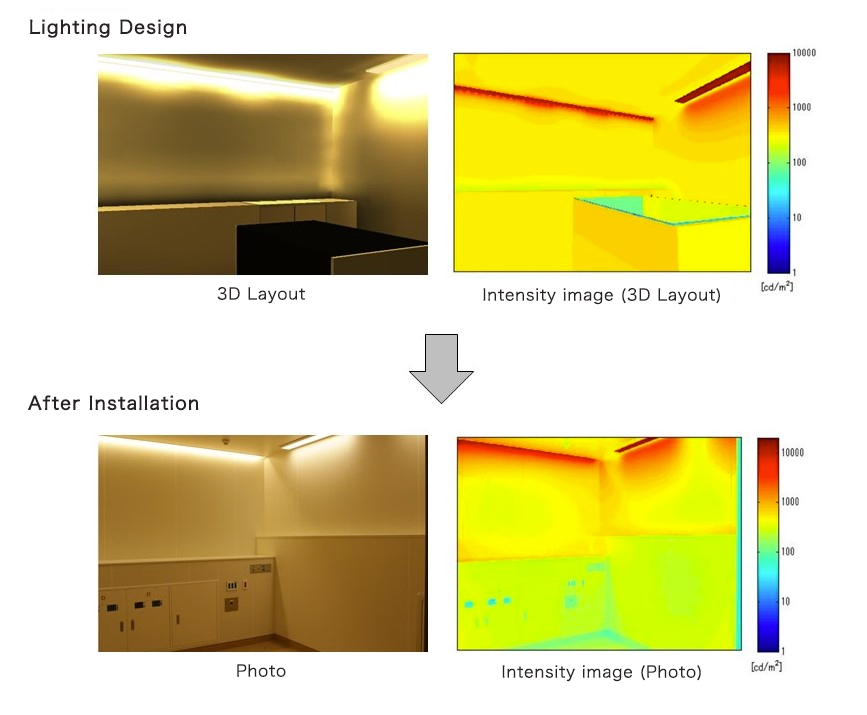
Suggested Light Environment for Whole Operating Room
- Facility
- Hachioji Digestive Disease Hospital of Nakayama Group (Hachioji, Tokyo)
- Installation Location
- Operating Room
- Equipment Installed
- Product Name: IXM-CJ Model: CJ1612/Low noise LED tubes (Ceiling lights)
- Hospital Information:
- Departments: Gastrointestinal surgery, Internal medicine, Proctology, Anesthesiology
Surgeries: 560 per year
This hospital valued our ability to offer not only shadowless lights, but an overall medical light environment.
Shadowless lamps: Offering operation identical to lights already in use
The facility had been using our older halogen shadowless lamps, and now installed our IXM-CJ products.
A representative had seen the IXM-CJ at a trade exhibition, and then requested a demonstration in one of the hospital’s operating rooms.
Since the new Medical LEDs offer lighting similar to halogen bulbs and operation similar to the accustomed shadowless lamps (arm rotation, focus adjustment, etc.), the client was impressed that replacement would cause very little disruption on-site.
Ceiling lights: Replacing with low noise LEDs
At the same time, we also installed ceiling lights in the operating room.
The hospital had been using fluorescent lights for many years, and was already considering moving to LEDs.
However, they had some concern over electronic noise interference from LED lights, so we offered low-noise tube-shaped LEDs, which cause a minimum of interference with medical equipment.
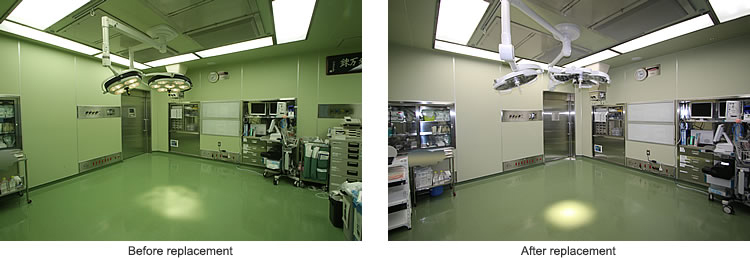
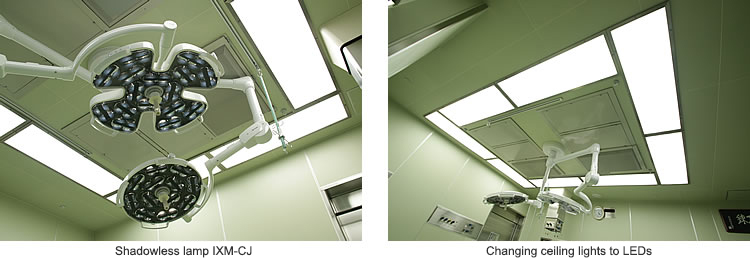
Coordinating and Connecting Medical Equipment Over a Network: “Smart Medical Rooms”
- Facility
- TWIns Tokyo Womens University–Waseda University Joint Institute for Advanced Biomedical Sciences
- Installation Location
- Veterinary Operating Room
- Equipment Installed
- Product Name: IXM-CJ Model: CJ
For this project, we asked Dr. Okamoto of the Tokyo Women’s Medical University, who arranged the design and installation of the various manufacturers’ equipment used, about the background of the “SCOT: Smart Cyber Operating Theater” project, as well about the lighting possibilities, and the future of medical robots pushing the boundaries of medical equipment.
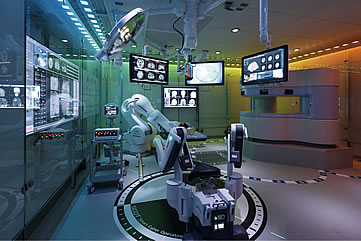
―SCOT uses OLEDs to provide multi-colored light in the operating room. Why is that?
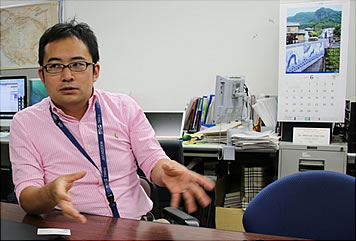
Dr. Okamoto:
Institute of Advanced Biomedical Engineering and Science (Tokyo Women’s Medical University), Graduate School of Medical Science and Biomedical Engineering and Science Major. Fields of Advanced Techno-Surgery:
Research into Medical Robot/Mechatronics.Involved in the development of surgical robots for neurosurgery and heart surgery.
Dr. Okamoto:
“Right now we’re working on the role of lighting in creating atmosphere. Some might be surprised that we’re using blue light like this, but soon clinical spaces will connect to OPe-LiNK and it will be possible to control the lighting color in response to the situation or location atmosphere. For example, if we come into contact with a dangerous area the lighting color will change. When surgeons are really intent they tend to talk less, but the rest of the staff often might not notice that. I think it would be useful if the environmental light could be changed to create awareness of dangerous situations that normally only clinical practitioners notice, and so information sharing among all staff would increase.”
―Hospital systems are incredibly complex, and it can be complicated trying to match the existing methods. Can you speak to the need for workflow standardization?
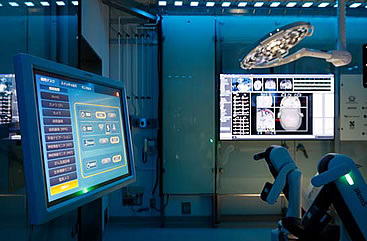
[Caption]
OpeLiNK, a system to integrate sharing of medical equipment basic data and images during surgery, surgical instrument location data, patient biological data etc.
Based on this, integrated surgical information can be displayed for surgical navigation, or equipment operation is monitored for failure analysis.
Various data gathered during surgery can be entered into a database for correlative analysis of events during surgery and thus help in improving treatment.
Dr. Okamoto:
“Yes, current hospital systems are incredibly complex. I’d like to input electronic patient files, electronic radiology files, PACS, anesthesiology records, and patient data connected all together at once under a single network ID as much as possible. The systems have gotten so complex because as each hospital tries to make their systems more efficient, they’ve also tried to match their own methodology. But there are increasingly more hospitals adopting systems with standardized workflows and changing their methodologies to match that. So for an OP plan, what do we input into which device, etc. How do we use that data?
The management of operating room information is also very important, so there needs to be some fixed process for that, too. I’d like to use such a planning system on SCOT. Shadowless lamps are a necessity for operating rooms. I’d like for the shadowless lamps to move according to that plan, as well. Hook them to the network and move them in a coordinated, efficient way. As we move through surgery, we need a trigger to announce the next step, and I’d like lighting to be that trigger. It could display the current surgical situation, and the lights could go off for 5 ALA or indocyanine examination. Since we’re in an operating theater, we can think of it as changing scenes, and I’d be happy if the lighting could help clarify the current scene.”
―What would you like to see from Japan’s medical device manufacturers in the future?
Dr. Okamoto:
“I want to see new products, and not necessarily robots. And by new I mean not just improved products, but totally new things. If a company hasn’t produced something new in 10 years, I start to doubt that company’s capabilities.
Development speed. Something can happen! I feel like times like that show the company has lost its footwork, and planning. I’m a roboticist, but not everything has to be a robot. It’s starting to bother me. I think Japan is a leader at robots for manufacturing. For making parts and such. For example, I think the master manipulators are extremely good. They work gently, moving passively even while the motor is active. They’re different from a robot like Davinci, but environmental robots or recent scene change systems for Kabuki plays are all programmed. Disneyland is the same way. The lighting changes. I feel like similar production styles could be useful in medical spaces.”
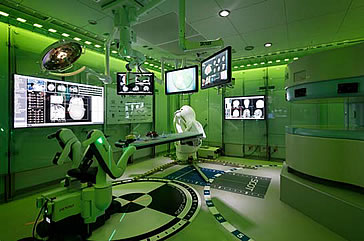
Dr. Okamoto:
“I think the area Japan really shows its strengths is not in robots but in space creation. Being able to make one car air conditioner a minute means being able to make one car a minute. Toyota’s JIT system means that they don’t keep stock, but continuously reduce the time needed for assembly and create a perfectly efficient system. Robots check the line and robots check the products, and this is all connected to ORiN. So Japan’s real strength isn’t creating from scratch, but constant improvement. I think it’s possible to apply a similar concept to operating rooms.
In Europe, they’re talking about Industry 4.0, but here I’d like to see gas administration, ventilation, and lighting systems consolidated into one with OPeLiNK.”
“Use in Oral Surgery”
- Facility
- Kajigaya Dental Clinic (Takatsu-ku, Kawasaki, Kanagawa Prefecture)/Special Examination Room (Operating Room)
- Installation Location
- Special Examination Room (Operating Room)
- Equipment Installed
- Product Name: IXM-CR Model: CRV04V
Taking the opportunity provided by relocation, Kajigaya Dental Clinic wanted to create a premium feeling with an all-white interior.
With that background, they chose to install our IXM-CR (CRV04V) in their unique, glass-walled Special Examination Room (Operating Room).
When selecting shadowless lamps for oral surgery use, the clinic director himself came to our MEDICAL LIGHTING LAB. He seemed particularly pleased with the gentle light and design of our Medical LEDs, as well as our Made in Japan “quality” and “maintenance responsiveness”.
The design of our IXM-CR blends seamlessly with the space, and continues to get compliments after purchase.

